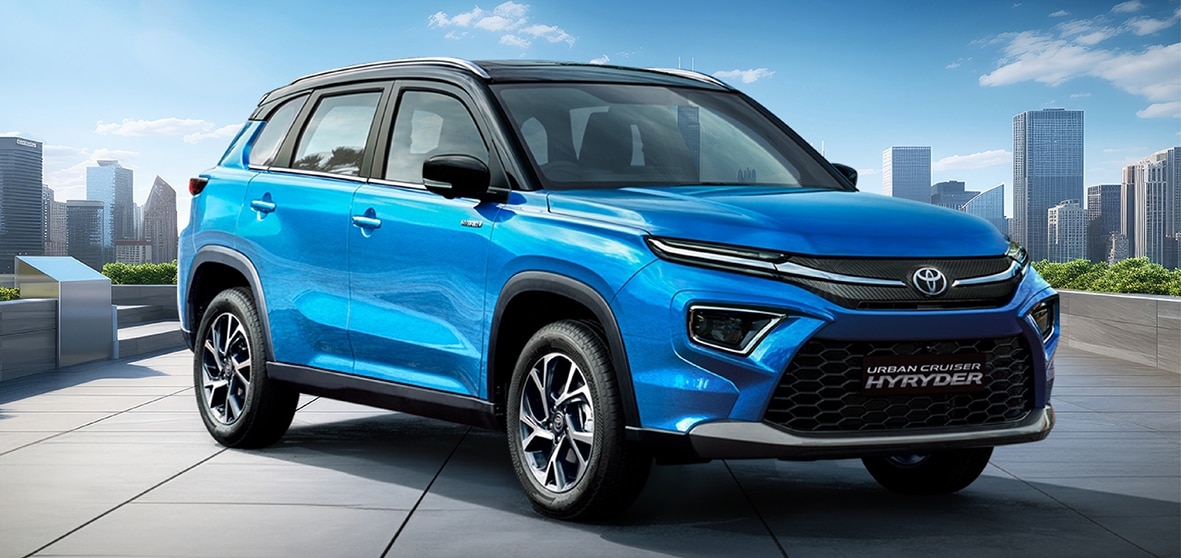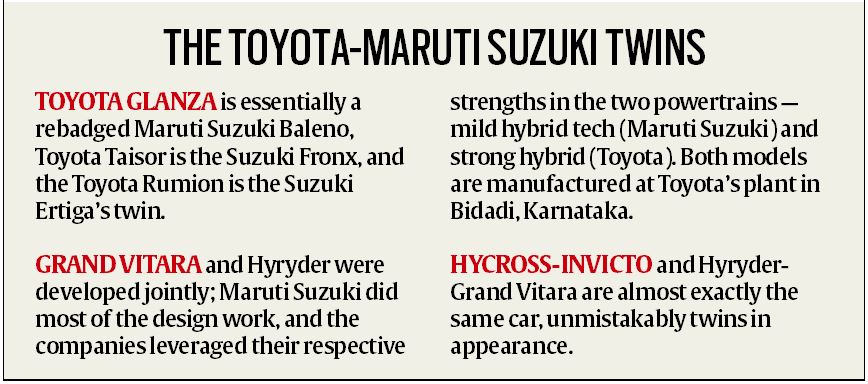Almost one in two cars sold by Toyota Kirloskar Motor over the past one year in India was a rebadged Maruti Suzuki product — which propelled Toyota to its best-ever wholesale figures and a more than 40% year-on-year growth in unit sales in FY24.
“Badge engineering” is proving to be an effective sales strategy for carmakers, and it is likely to remain popular in the new year. What is it, and why is it working so well for manufacturers such as Toyota and Suzuki in India?
Platform sharing, with tweaks
Badge engineering refers to the sharing of a platform or an entire vehicle by different car manufacturers, with at least one of them not needing to design or engineer a new model from scratch.
Thus, two differently branded cars can share the same platform, broad design cues, and the engine or parts of it, with perhaps some of the aesthetics tweaked to align with the design characteristics of the individual brands.
There are differences in aims and degrees — so, rebadging could produce completely different cars from the same platform, or maybe just swap badges with little else done to give each car a different or distinctive look.
 The Toyota and Maruti Suzuki twins on Indian roads are the most visible examples of this success. ‘Badge engineering’ goes back a century, but has not always worked out for manufacturers.
The Toyota and Maruti Suzuki twins on Indian roads are the most visible examples of this success. ‘Badge engineering’ goes back a century, but has not always worked out for manufacturers.
For a century, from GM to Tata
One of the first documented cases of badge engineering dates back to 1909, when General Motors started sharing its chassis and platforms with all its different brands.
So GMC, which was traditionally identified as a truck builder, began to offer its products with Chevrolet bending on the hood — and vehicle platforms were progressively shared with the other GM brands including Oakland, Oldsmobile, Buick, and Cadillac. Exterior appearances were upgraded and interiors were spruced up for the premium brands such as Buick and Cadillac.
In India, the Hindustan Motors Ambassador was probably the earliest successful badge-engineered product, with a production life from 1957 to 2014. At its core, the good old Ambassador was a rebadged Series III Morris Oxford.
The Rover CityRover, marketed by the former British manufacturer MG Rover under the Rover marque from 2003-05, was a rebadged version of the Tata Indica.
While the Indica was a success in India, the souped-up Rover version was pummelled in the United Kingdom as a crude attempt to keep MG Rover out of bankruptcy.

The costs and the benefits
The auto industry is highly capital intensive, and economies of scale matter. By producing more of the same, companies can share costs and increase volumes, while keeping overheads low by spreading investments across models.
While most consumers know the cars are similar, they can base their buying decision on factors such as familiarity with a particular brand, the warranty on offer, or the convenience of reaching a dealership. And carmakers can position themselves as builders of a premium product that costs more than the models they are generally associated with.
Companies also get the opportunity to widen their customer base in both directions — thus, Maruti Suzuki can reach the upward end of consumer segments, and Toyota Kirloskar can tap consumers at the lower end.
Maruti Suzuki can offer a Grand Vitara owner an upgrade to an Invicto premium utility vehicle — a rebadged Toyota Innova Hycross — which allows it to retain customers even as they move up the price bracket.
For Toyota, there is the option of offering customers multiple options in the lower-end segment, where it has traditionally struggled in India. With the Taisor and Glanza in Toyota showrooms, a Fortuner owner now has the option to buy a smaller second car.
The partnership also enables Toyota to offer cars kitted with the CNG option, a big draw in the utility vehicle segment.
While the Toyota-Maruti Suzuki twins are practically the same cars, the Toyota versions tend to be slightly more expensive. For instance, the Taisor is about Rs 22,000-25,000 costlier than the Fronx variants with the 1.2-litre petrol engine. The trims with the more premium 1.0-liter turbocharged engine are almost identically priced, however.
In the case of the Grand Vitara, Maruti sells more of the lower-priced mild hybrid variants, while Toyota sells higher volumes of the strong hybrids. Executives in both companies say this is not the result of a deliberate strategy, but is related more to the consumer-pull effect.
Collaborating, not twinning
The other type of cross-brand partnership involves collaboration at the platform level, when the cars are being developed.
In the Indian market, the Hyundai Creta and Kia Seltos have pretty close underpinnings, although they’re not as alike as the Hyryder and Grand Vitara. The other example is the Hyundai Venue and Kia Sonnet.
The Hyundai-Kia cars have some similarities in their basic platforms and share some engines and gearbox options, but much of this collaboration is seeded at, and limited to, the early development stages. After that, the two South Korean companies — Kia is a subsidiary of Hyundai — fiercely compete in the markets they are sold in.
Germany’s Volkswagen and its Czech group subsidiary Skoda have had a similar partnership, visible in the case of the VW Taigun and Skoda Kushaq, or VW Virtus and Skoda Slavia. In these models, while the basic platform may be shared or broadly similar, there are marked differences in parameters such as appearance, ground clearance, or the engines and gearbox options.
Limits and some lessons
While Toyota and Maruti Suzuki’s brand engineering partnership has been a winner, others have struggled with it.
Renault and Nissan tried it, with the Terrano being offered as a badge-engineered Duster, and the Japanese company offering its Sunny as the Renault Scala. Both the Nissan Terrano and the Renault Scala flopped.
Some flagship models have been kept out of bounds — for instance, Suzuki has not shared the Swift or Jimny with Toyota, and the latter has not offered the Innova Crysta or Fortuner to its partner.
Badge engineering has been tried out across price segments as well.
The iconic British sports car maker Aston Martin put Toyota’s city car iQ on the road in 2011. The Aston Martin Cygnet was a Toyota iQ with more bells and whistles, some cosmetic restyling, and a big jump in the price tag. Autocar UK recorded that the car sold very poorly, and Aston Martin has not attempted anything similar since.
The Audi 50 — the smallest Audi ever — was actually the first-generation VW Polo, which was interestingly launched even before the Polo’s production had begun. The Polo went on to win over customers across markets, while the Audi 50 was soon discontinued.
Discover the benefits of our subscription!
Stay informed with access to our award-winning journalism.
Avoid misinformation with trusted, accurate reporting.
Make smarter decisions with insights that matter.
Choose your subscription package
